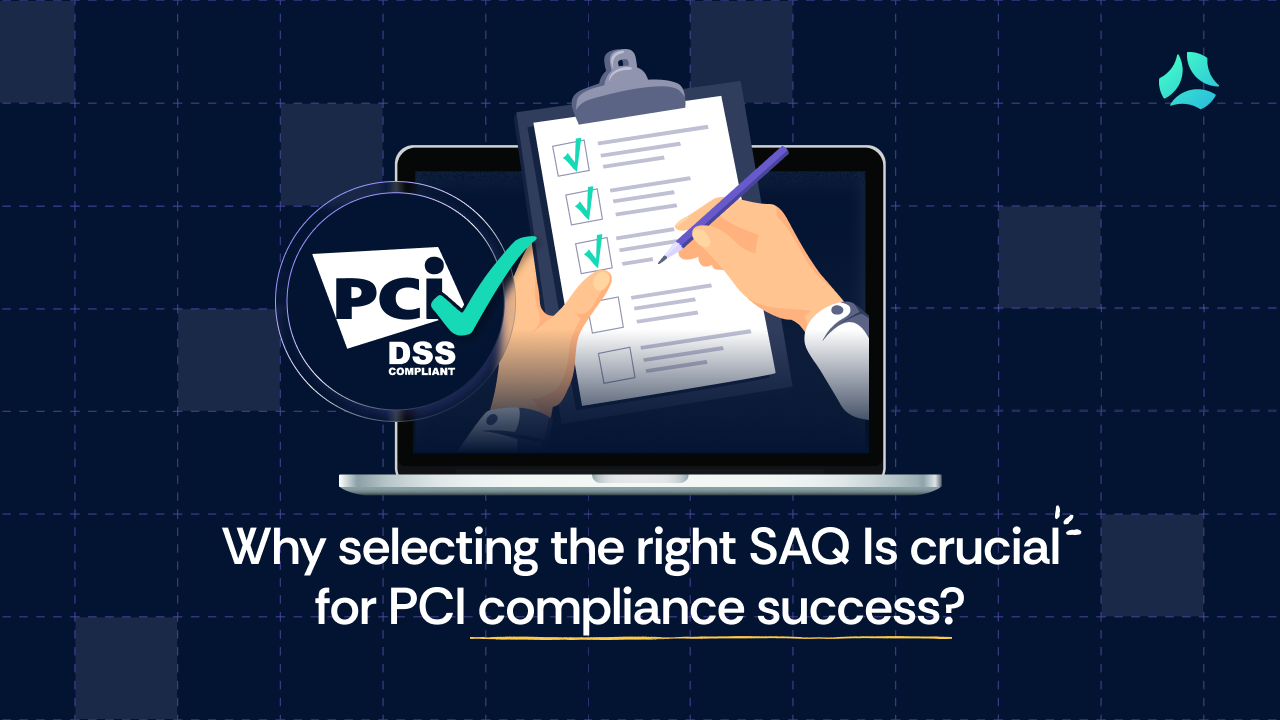PCI SAQ selection: Why it matters and how to choose the right one

Small businesses processing credit card payments face a complex compliance landscape where incorrect self-assessment questionnaire (SAQ) selection can significantly increase costs and create dangerous security gaps. With PCI DSS 4.0.1 mandatory since April 2024 and new requirements taking effect, understanding SAQ types has become critical for business survival. Mistakes in compliance can lead to substantial additional expenses, operational disruptions, and exposure to security risks, underscoring the need for careful SAQ selection and up-to-date adherence to evolving standards.
Many small business owners face uncertainty around choosing the right SAQ types, worry about over-committing to unnecessary controls, and feel weighed down by the manual evidence collection that traditional compliance approaches demand. The solution lies in systematic SAQ selection and automated compliance solutions that transform regulatory burden into competitive advantage. This enables small teams to achieve comprehensive security without disrupting core business operations and staying ahead of audit and partner demands.
Why SAQs matter in PCI compliance?
Small businesses often perceive PCI compliance as an expensive, complex requirement that only large enterprises need to worry about. This misconception creates dangerous gaps in security posture and exposes companies to significant financial and operational risks. The reality is that any business processing even one credit card transaction annually must comply with PCI DSS requirements, regardless of size or transaction volume. Non-compliance can result in substantial penalties ranging from $5,000 to $100,000, plus potential loss of payment processing privileges that could devastate small business operations.
SAQs help small-to-medium businesses avoid full audits by providing a structured self-assessment pathway that validates security controls without requiring expensive on-site evaluations by qualified security assessors. For businesses processing fewer than 6 million card transactions annually, completing the appropriate PCI DSS Self-Assessment Questionnaire (SAQ) is considered the most cost-effective method for validating compliance, compared to undergoing a formal audit. The average cost of completing an SAQ typically ranges from $5,000 to $20,000, whereas a formal Report on Compliance (ROC) audit conducted by a Qualified Security Assessor can range from $35,000 up to $200,000. This substantial difference underscores the financial advantage of the SAQ process for qualified small and medium-sized businesses. The shortest SAQ contains just 31 questions, while the most comprehensive includes over 250 requirements, demonstrating how proper SAQ selection directly impacts implementation complexity and resource allocation.
This streamlined approach enables small businesses to demonstrate compliance quickly while focusing resources on core business activities rather than lengthy audit processes. Choosing the wrong SAQ can increase effort and risk non-compliance by forcing businesses into unnecessarily complex requirements or creating gaps in security coverage. A business incorrectly selecting SAQ A instead of SAQ A-EP faces over 100 additional requirements, dramatically increasing implementation costs and timeline. Understanding SAQ eligibility criteria and selecting the appropriate questionnaire becomes the foundation for efficient, cost-effective compliance that protects both customer data and business continuity.
What is a PCI self-assessment questionnaire (SAQ)?
When you receive SAQ requirements from your payment processor or bank, the regulatory terms and technical questions can leave you guessing. This leads to incorrect answers, which may delay your submission or force you to hire expensive consultants for what should be a straightforward self-assessment.
A PCI SAQ is designed to simplify that process. It consists of two parts: a set of targeted questions about specific security controls, and an attestation of compliance (AoC) that you send to your payment provider. Each question asks whether a control is “In place,” “In place with compensating control,” “Not in place,” “Not applicable,” or “Not tested.” This structure means you can clearly evaluate your security posture without guessing which controls apply.
Because SAQs replace the need for a full report on compliance (ROC) audit, you avoid costly on-site assessments. This frees up your budget and your team’s time, so you can focus on growing your business rather than on audit logistics.
By following the SAQ framework, you gain clear guidance on the exact security measures you need. This turns compliance from an overwhelming burden into a manageable, step-by-step process that keeps you secure and audit-ready without diverting resources from your core operations.
PCI SAQ types explained (At-a-glance table)
The existence of multiple SAQ types often creates confusion for small business owners who assume all payment processing requires the same compliance approach. This misunderstanding leads to selecting inappropriate questionnaires that either create unnecessary complexity or fail to address actual security requirements. The variety of SAQ types reflects the diversity of payment processing methods and business models, ensuring that compliance requirements align with actual risk levels and operational realities rather than applying one-size-fits-all requirements.
How to choose the right SAQ for your business
Proper SAQ selection requires a systematic evaluation of your payment processing methods, technical infrastructure, and data handling practices. This methodical approach ensures accurate classification while identifying potential issues before they become compliance problems.
Step 1: Identify how you accept card payments
Begin by documenting all payment channels, including in-person transactions, online payments, phone orders, and mail orders, with careful attention to how different channels interact and affect overall compliance requirements.
Each payment method may have different SAQ implications, and businesses often operate multiple channels, requiring careful analysis of system integration, technology stack, and customer interaction points that could affect classification.
Consider seasonal variations, special event processing, and any planned expansion of payment methods that could impact your SAQ selection over the annual compliance period.
Step 2: Understand whether you store, transmit, or process cardholder data
Conduct a thorough cardholder data flow analysis throughout your entire technology infrastructure, including all systems, databases, applications, logs, backups, and temporary storage locations.
Many businesses unknowingly handle cardholder data in unexpected places, such as web server logs, email systems, call recordings, or integrated business applications, affecting SAQ eligibility and requiring proper classification of all data handling practices.
Pay particular attention to data retention policies, backup procedures, and any business processes that might temporarily capture payment information during normal operations.
Step 3: Evaluate third-party involvement
Review all relationships with payment processors, gateways, hosting providers, and integrated service providers to understand the extent of outsourcing and residual merchant responsibilities. Complete outsourcing may qualify businesses for simpler SAQs, while partial outsourcing or retained control over payment elements requires more comprehensive assessments with additional security controls and monitoring requirements. Document the service provider's PCI compliance status and obtain current attestations to verify coverage and identify any gaps in protection that could affect your SAQ classification.
Step 4: Check infrastructure, including on-premises systems, cloud environments, network connectivity, and payment terminal integration
Assess on-premises systems, cloud environments, network connectivity, and payment terminal integration to understand how internet connectivity, system integration, network segmentation, and data storage capabilities influence SAQ applicability. Businesses using standalone terminals may qualify for simpler SAQs, while integrated point-of-sale systems or custom applications typically require more comprehensive assessments with additional security controls. Consider future technology changes, planned integrations, and system upgrades that might affect your compliance requirements during the annual assessment period.
This systematic evaluation process eliminates guesswork while ensuring a comprehensive understanding of your compliance requirements. The result is a confident SAQ selection that accurately reflects your business model, optimizes compliance efficiency, and ensures appropriate security coverage without unnecessary complexity or resource waste that could impact business operations or growth initiatives.
Common mistakes when choosing an SAQ
1. Website involvement in payment processing
Many businesses assume that using a payment processor automatically qualifies them for the simplest SAQ, but merchant websites controlling payment page elements, customer redirection, or data collection require SAQ A-EP classification with over 100 additional requirements and substantially increased implementation complexity.
Recent PCI DSS 4.0.1 updates specifically address this issue by requiring additional script monitoring and protection measures for merchants using embedded payment forms or JavaScript implementations. The distinction between SAQ A's 31 requirements and SAQ A-EP's 191 requirements can dramatically impact both implementation timeline and ongoing maintenance costs, making accurate classification essential for resource planning.
2. Virtual terminal misclassification
Businesses manually entering cards through web browsers should use SAQ C-VT rather than the more complex SAQ C, but this distinction often gets overlooked when businesses focus on internet connectivity rather than actual data processing methods.
The critical difference lies in manual entry versus automated processing systems, with virtual terminals requiring specific isolation and access controls rather than comprehensive application security measures typically associated with automated payment systems. This misunderstanding can result in implementing inappropriate security controls that don't address actual risks while creating an unnecessary operational burden.
3. Third-party responsibility assumptions
While processors handle many security functions, merchants retain responsibility for access controls, employee training, incident response, and service provider management under PCI DSS requirements. Even fully outsourced environments require merchant oversight and validation of service provider compliance status with ongoing monitoring of relationships.
This misconception becomes particularly dangerous when businesses assume their compliance responsibilities end with selecting a PCI-compliant processor, potentially creating gaps in security coverage that could be exploited during security incidents.
These common mistakes demonstrate why automated SAQ selection tools and expert guidance provide significant value in avoiding costly errors that could impact business operations, compliance status, and customer trust. Proper classification from the beginning prevents implementation delays, reduces costs, and ensures comprehensive security coverage appropriate to actual business operations and risk levels.
How Scrut simplifies PCI SAQs for you
Scrut simplifies every step of PCI SAQ compliance so you can focus on growing your business.
1. Pre-mapped controls by SAQ type
You no longer need to figure out which controls apply to your assessment. Scrut provides over 100 pre-built policies and control templates tailored to each SAQ type. When you select your SAQ, the platform automatically maps exactly the controls you need. You can adjust templates to match your workflows while ensuring full alignment with PCI DSS requirements.
2. Guided scoping questions to determine the right SAQ
Choosing the wrong SAQ wastes time and leaves gaps in your compliance. Scrut walks you through a short set of scoping questions about your payment flow, systems, and integrations. Its scoping engine analyzes your answers and recommends the exact SAQ for your environment. This removes guesswork and prevents scope errors from day one.
3. Evidence collection workflows specific to your SAQ version
Manual evidence collection—screenshots, logs, configuration notes—can consume hundreds of hours each year. Scrut automates roughly 65 percent of that work by integrating with AWS, Azure, HR systems, security tools, and other applications. These workflows collect and store evidence against your specific SAQ controls, so you maintain up-to-date records without lifting a finger.
4. Auto-generated SAQ forms and attestation documents
Filling out forms by hand introduces errors and delays. Scrut auto-generates your SAQ questionnaire and attestation documents with accurate, evidence-backed responses. When it’s time to audit, you share these documents directly from the platform, assign remediation tasks, and track progress in one centralized workspace.
Find your correct SAQ path in minutes with Scrut—book a demo to discover how automation can eliminate guesswork and manual tasks while providing the foundation for sustainable growth and customer confidence in an increasingly competitive marketplace.


















